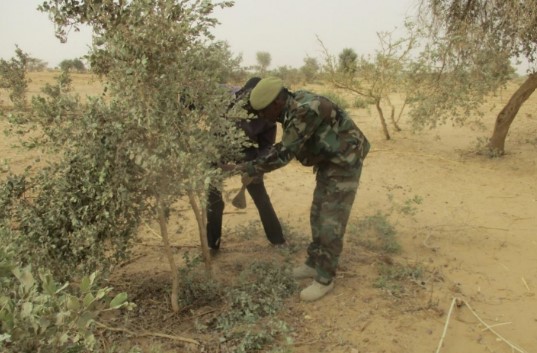Assisted Natural Regeneration (ANR)

Assisted Natural Regeneration (ANR) is a practice that involves sparing and maintaining shoots and saplings of various woody species during field preparation according to the needs of the producer. It is also a practice that allows for the easy integration of trees into agro-pastoral production systems.
Objectives
- Improve soil fertility and agricultural production.
- Protect cultivated lands against wind and water erosion.
- Promote the re-establishment of vegetation cover.
- Produce firewood, construction wood, and timber.
- Ensure the production of non-timber forest products.
- Produce fodder for animals.
- Increase the carbon sequestration capacity of agro-ecosystems.
- Preserve endangered or extinct forest species.
Context / Environmental conditions
ANR can be implemented on all lands and soil types in the agricultural systems of the Sahelian and Sudanian climates. It is carried out on both individual and collective farms, generally intended for rain-fed crops, while respecting the tree densities associated with crops.
Implementation steps
- Identify the stumps and young shoots to protect: It is preferable to prioritize nitrogen-fixing species.
- Select 3 to 5 vigorous shoots per chosen stump.
- Identify and protect young shoots using markers.
- Prune the selected shoots.
- Gradually reduce and maintain them.
Technical characteristics
- Tree density: In Niger, the density ranges from 25 to 400 trees/ha depending on the woody species and the spread of their canopies. In association with cereals, it is 50-100 trees/ha.
- Large species (e.g., Prosopis africana, Faidherbia albida): 25 to 40 trees/ha.
- Medium species (e.g., Balanites aegyptiaca, Bauhinia rufescens): 100 trees/ha.
- Shrub species (e.g., Combretaceae): 400 trees/ha.
Pruning period
Prune trees during the period of vegetative awakening or bud break (May-June) to maximize wound closure, reduce the risk of disease transmission, and avoid excessive sap loss through wounds. Trees can also be pruned after fruiting (September-October or May-June) to allow young branches to regrow for the next fruiting period.
Young shoot identification period
During weeding operations in July-August.

Technical equipment
Tools include a machete, hoe, axe, and rake.


Management, appropriation, and sustainability measures
- Prune and trim young plants periodically.
- Create basins around the plants.
- Set up stakes if needed.
- Clean around the plants.
- Perform sanitary cuts.
- Carry out pollarding.
- Protect young plants from animal roaming (individual baskets, cow dung coating, guarding), bush fires (weeding, firebreaks, mulching), and competition from weeds (weeding).

Advantages
- Creation of a microclimate favorable to the development of biodiversity.
- Control of water and wind erosion.
- Improvement of agricultural production.
- Restoration of animal and plant biodiversity.
- Preservation of extinct or endangered species.
- Improvement of human and animal health through traditional herbal medicine.
- Improvement of the livestock system in the area by providing fodder from woody plants.
- Increase in income for farmers through the sale of timber and non-timber products.
- Time savings in collecting firewood for women.
- Drought resistance.
- Disease resistance.
- Grazing resistance of livestock.
- Plants adapted to environmental conditions.
- Mitigation of climate change.
Disadvantages / Constraints
- Limited knowledge of the biology and physiology of local species.
- Illegal logging.
- Animal roaming.
- Habitat for birds that may harm crops.
Cost of the technique
Cost of the technique per hectare. Note: These costs are indicative and may vary depending on the context.
| Items | Unit | Quantity | Unit Price
(CFA Franc) |
Amount
(CFA Franc) |
| Labor | H/J | 4 | 2 000 | 8 000 |
| Machete | Unit | 2 | 2 000 | 4 000 |
| Hoe | Unit | 2 | 2 000 | 4 000 |
| Axe | Unit | 2 | 2 000 | 4 000 |
| Rake | Unit | 2 | 3 000 | 6 000 |
| Monitoring and
maintenance over 3 years |
H/year | 3 | 20 000 | 60 000 |
| Total investment | 86 000 |
Lifespan
ANR is practiced year-round and throughout the entire lifespan of the tree.
References
- Ministry of Environment, Urban Sanitation, and Sustainable Development (ME/SU/DD), 2020. Decree RNA_2020-602 PRN_ME/SU/DD regulating the practice of ANR in Niger, 6 pages.
- Ministry of Agricultural Development (MDA), 2006. Collection of technical sheets on natural resource management and agro-silvo-pastoral production, Niamey, Niger, Community Action Program (PAC). 270 pages.
- Larwanou M., Oumarou I., Laura S., Danguimbo I., and Eyog-Matig O. (2010): Silvicultural and cropping practices in agroforestry parks following a north-south rainfall gradient in the Maradi region of Niger, in Tropicultura, 2010, pp. 115-122.
Sources
This page was written in partnership with the Urbane project and with the financial support of the European Union.

